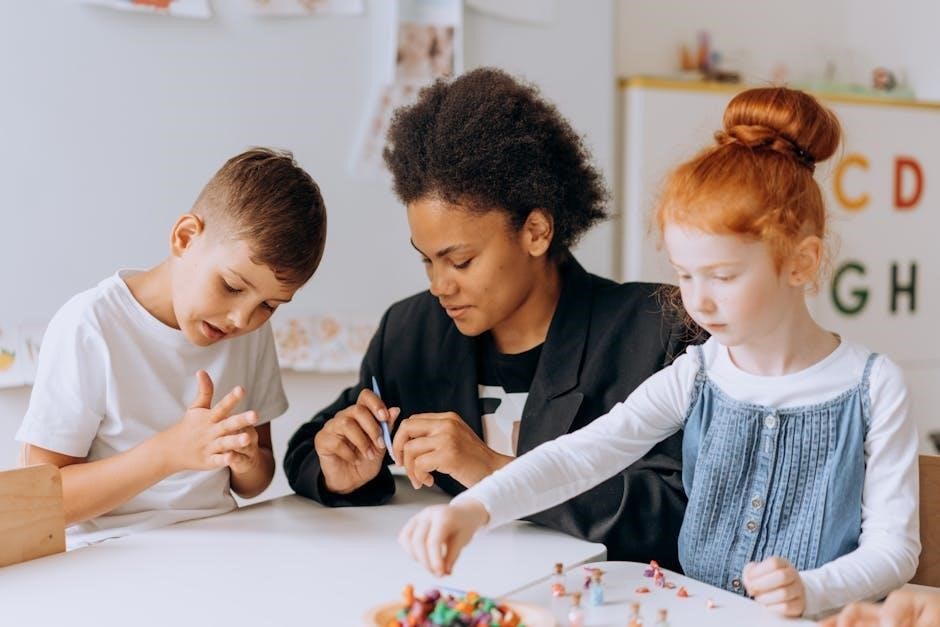Welcome to Black History Month! This February, explore engaging activities that celebrate African-American heritage, contributions, and culture through fun, educational, and creative experiences for young learners.
Overview of Black History Month
Black History Month, celebrated annually in February, honors the contributions, achievements, and rich cultural heritage of African Americans. Originating from Negro History Week in 1926, it was expanded to a full month in 1986. This observance highlights the struggles, triumphs, and impactful roles Black individuals have played in shaping history. It serves as a time for education, reflection, and celebration of diversity and equality.
Importance of Teaching Black History to Elementary Students
Teaching Black History to elementary students fosters empathy, understanding, and appreciation for diverse cultures. It highlights the contributions and achievements of Black individuals, promoting inclusivity and equality. Early exposure helps students recognize the richness of African-American heritage, encouraging them to value diversity and understand its significance in shaping history. This education also builds self-esteem in Black students while broadening perspectives for all learners.

Age-Appropriate Activities for Elementary Students
Engage young minds with creative, educational activities that celebrate Black History Month, fostering cultural awareness and appreciation through interactive learning experiences designed for elementary-aged students.
Interactive Classroom Discussions
Foster meaningful conversations about Black History Month through guided discussions, brainstorming sessions, and collaborative activities. Encourage students to share thoughts on historical figures, cultural contributions, and personal reflections. Use think-pair-share or small group discussions to make learning engaging and inclusive. Incorporate role-playing to bring historical events to life. End with reflection circles to deepen understanding and appreciation of diversity and inclusion.
- Discuss the significance of Black History Month.
- Explore contributions of African-American leaders.
- Share personal stories and cultural traditions.
Hands-On Crafts and Art Projects
Engage students with creative crafts that celebrate African-American culture. Projects like making African-inspired masks, designing freedom quilts, or crafting Harriet Tubman-inspired lanterns bring history to life. Students can create murals of Black heroes or build models of historical landmarks, fostering creativity and cultural appreciation. These activities make learning interactive and memorable while honoring Black heritage.
- Create traditional African patterns and textiles.
- Make collages of Black history figures.
- Design Kente cloth-inspired art.
Storytelling and Book Readings
Storytelling and book readings are powerful tools to connect students with Black history and culture. Select books by Black authors that highlight African-American experiences, achievements, and traditions. Engage students with read-aloud sessions, followed by discussions to foster understanding and empathy. Encourage students to share personal stories or family histories, creating a meaningful link to the curriculum.
- Read-alouds of award-winning books like The Watsons Go to Birmingham.
- Discuss stories of Black heroes and their contributions.
- Reflect on how stories relate to students’ own lives.

Black History Month Art and Music Activities
Engage students with African-inspired art projects and music, fostering creativity and cultural connection. Explore works by Black artists and musicians, inspiring appreciation and pride in heritage.
Creating African-Inspired Art
Students can explore African culture through art by creating traditional patterns, masks, and textiles. Use natural materials like beads, wood, and fabric to craft meaningful pieces. Introduce iconic African artists and their styles, encouraging students to express their own creativity. Activities like tie-dye, batik, and collage-making foster cultural appreciation and artistic skill. Display artwork in the classroom or school hallway for a vibrant celebration of African heritage and student creativity.
Learning About Famous Black Musicians
Introduce students to legendary Black musicians like Louis Armstrong and Aretha Franklin, exploring their contributions to music and culture. Play their iconic songs and discuss their historical significance. Create interactive activities, such as sing-alongs or rhythm exercises, to engage students. Highlight how these artists inspired future generations, fostering appreciation for Black musical heritage and its global impact.
Singing Traditional African-American Songs
Engage students with traditional African-American songs like spirituals and gospel music. Teach songs such as “Wade in the Water” or “This Little Light of Mine,” explaining their historical significance. Use simple arrangements and movements to make learning fun. Discuss how these songs reflect resilience and hope, deepening students’ connection to Black cultural heritage while fostering musical appreciation and teamwork through group singing activities.

Literacy-Based Activities
Engage students with books by Black authors, essay writing on Black heroes, and poetry inspired by African-American culture, fostering a deeper connection to literacy and heritage.
Reading Books by Black Authors
Reading books by Black authors introduces students to diverse perspectives and experiences, fostering empathy and understanding. Choose stories that highlight African-American culture, history, and achievements. Engage students with discussions, reading circles, and reflective journals to deepen comprehension. This activity celebrates Black heritage while promoting literacy and inclusivity in the classroom.
Writing Essays on Black Heroes
Writing essays on Black heroes introduces students to inspiring individuals who shaped history. Exploring their stories helps students understand challenges and triumphs, fostering empathy and admiration. This activity encourages reflection on values and achievements, making history relatable. It enhances writing skills and critical thinking, fostering pride in diverse experiences and sparking creativity and appreciation for their lasting impact.
Creating Poetry Inspired by Black Culture
Creating poetry inspired by Black culture encourages students to express emotions and ideas through creative writing. This activity allows exploration of heritage, traditions, and contributions of African-Americans. By using imagery and rhythm, students connect with meaningful themes, fostering cultural appreciation. Sharing poems in class builds confidence and understanding, celebrating diversity through the power of words.
STEM and History Integration
STEM meets history by exploring inventions, landmarks, and scientists. Students learn about Black inventors, build models of historical sites, and conduct science experiments inspired by Black innovators.
Learning About Black Inventors
Engage students in discovering the contributions of Black inventors like Madam C.J. Walker, George Washington Carver, and Elijah McCoy. Explore their groundbreaking inventions and how they shaped society. Use interactive discussions, biographical readings, and hands-on activities to inspire curiosity and appreciation for their impact on science, technology, and daily life. This fosters a deeper understanding of Black history and innovation.
Building Models of Historical Black Landmarks
Students can create scale models of iconic Black landmarks like the Martin Luther King Jr. Memorial or the Apollo Theater. Using cardboard, clay, or 3D printing, they research and replicate architectural details. This activity teaches history, design, and cultural significance while fostering creativity and critical thinking. It connects students to the heritage and contributions of African-Americans in shaping meaningful spaces.
Science Experiments Inspired by Black Scientists
Elementary students can explore science experiments inspired by trailblazing Black scientists like Mae Jemison, George Washington Carver, and Katherine Johnson. Activities include growing plants to mimic Carver’s agricultural innovations, creating solar system models to honor Jemison’s space travels, or conducting math-based experiments inspired by Johnson’s calculations. These hands-on projects celebrate Black contributions to STEM while fostering curiosity and learning.

Field Trips and Guest Speakers
Organize visits to museums celebrating African-American history and invite guest speakers to share inspiring stories, fostering real-life connections to Black culture and achievements.
Visiting Black History Museums
Visiting Black history museums offers students a hands-on learning experience, exploring exhibits that highlight African-American achievements and cultural heritage. Interactive displays and artifacts bring history to life, fostering a deeper understanding of contributions to science, art, and civil rights. Guided tours and educational programs tailored for elementary students make these visits engaging and memorable, while reflection activities help students connect their learning to real-world contexts.
Inviting Guest Speakers to Share Experiences
Inviting guest speakers to share their experiences enriches students’ understanding of Black history and culture. Speakers such as local community leaders, historians, or artists can provide personal insights and stories, making learning interactive and relatable. This activity fosters empathy and inspires students to appreciate the contributions of African-Americans while encouraging them to engage with their own heritage and community.

Community Involvement Activities
Engage students in community-based projects celebrating Black History Month; Collaborate with local organizations for cultural events, service projects, and shared learning experiences that foster unity and appreciation.
Hosting a School-Wide Black History Event
Organize a school-wide celebration featuring performances, exhibits, and activities that highlight African-American culture. Involve students, teachers, and families in planning and participating. Include interactive displays, music, and art to create an engaging and educational experience. Decorate the venue with historical figures, cultural symbols, and student creations to foster pride and understanding. This event promotes unity and celebrates the rich heritage of Black History Month.
Participating in Local Black History Parades
Join local Black History Month parades to celebrate African-American culture and achievements. Students can participate by creating floats, wearing traditional attire, or performing music and dances. This event fosters community engagement and pride, offering a hands-on learning experience. It’s a joyful way to honor heritage while educating students about the contributions of Black leaders and their impact on history and society.

Digital Resources for Black History Month
Explore educational apps, documentaries, and interactive timelines that bring Black History Month to life. These tools enhance learning and engagement for elementary students in a fun, digital way.
Using Educational Apps for Black History
Educational apps offer interactive lessons, quizzes, and games that teach students about Black History Month. These apps feature biographies of influential figures, historical events, and cultural traditions, making learning engaging and accessible for elementary students. They also include activities that promote critical thinking and creativity, ensuring a well-rounded understanding of African-American contributions and experiences. This digital approach fosters excitement and deeper learning.
Watching Documentaries for Kids
Documentaries designed for children provide an engaging way to explore Black History Month. These films highlight key figures, events, and cultural experiences in an age-appropriate manner. They often include animations, kid-friendly narration, and relatable storytelling to capture young minds. Documentaries can spark curiosity and foster empathy, helping elementary students connect with the rich history and contributions of African-Americans in a visually immersive way.
Assessment and Reflection
Evaluate students’ understanding through quizzes and reflective journals. These tools help measure knowledge retention and encourage thoughtful insights about Black History Month’s significance and personal connections.
Quizzes to Test Knowledge
Engage students with quizzes designed to assess their understanding of Black History Month. Use age-appropriate questions to test knowledge of key figures, events, and cultural contributions. Quizzes can be individual or group activities, fostering healthy competition and teamwork. This method ensures comprehension while making learning fun and interactive, helping teachers track progress and identify areas for further exploration.
Student Reflection Journals
Student reflection journals encourage learners to express their thoughts and feelings about Black History Month. Through daily or weekly entries, students can reflect on lessons, share personal connections, and document their growth. Journals help deepen understanding, foster empathy, and provide a creative outlet for processing historical and cultural content. They also serve as a meaningful keepsake of their learning journey throughout the month.
Cultural Food and Celebrations
Cultural food and celebrations bring African and African-American traditions to life. Students enjoy cooking and sharing dishes, learning about their history and fostering community connections through food.
Cooking Traditional African and African-American Dishes
Cooking traditional dishes introduces students to rich culinary heritage. Activities include preparing soul food, like fried chicken and collard greens, or African dishes such as jollof rice and fufu. Students learn about the cultural significance of these meals, fostering an appreciation for diverse traditions. This hands-on experience connects history with flavor, making learning fun and memorable for young participants.
Hosting a Cultural Food Tasting Event
Host a cultural food tasting event where students sample traditional African, African-American, and Caribbean dishes. This interactive activity allows students to explore diverse flavors and learn about their origins. Encourage discussions about the historical and cultural significance of each dish, fostering appreciation for the rich culinary heritage. This event connects food, culture, and community, making it a memorable Black History Month experience.

Family Involvement Activities
Engage families through homework assignments exploring students’ heritage and cultural contributions, fostering a deeper connection to Black History Month and creating a shared learning experience.
Homework Assignments on Family History
Encourage students to explore their family’s cultural heritage by interviewing relatives and researching ancestral contributions. Assignments might include creating a family tree, writing short biographies of influential family members, or compiling traditional recipes and stories. This helps students connect their personal history to the broader celebration of Black History Month, fostering pride and understanding of their roots.
Creating a Family Heritage Project
Students can create a family heritage project by gathering photos, stories, and artifacts that represent their cultural background. They can design a visual timeline or scrapbook showcasing their family’s history and contributions. This project encourages students to explore their roots and share how their family’s story connects to the broader celebration of Black History Month, fostering pride and cultural awareness.

Concluding Black History Month
End Black History Month with a reflection on the rich cultural experiences and lessons learned. Celebrate the achievements and contributions that shape our shared history and future.
Hosting a Final Celebration
Conclude Black History Month with a vibrant celebration! Organize a school-wide event featuring student performances, African-inspired art displays, and a cultural food tasting. Encourage students to share reflections on what they’ve learned. Include a photo booth with props and a playlist of African-American music. Recognize student achievements and distribute certificates for their participation. This joyful event will leave a lasting impression and inspire continued learning.
Reflecting on What Was Learned
Foster meaningful reflection by having students journal their thoughts on Black History Month. Ask them to highlight key figures, traditions, and lessons that resonated. Create a class discussion to share insights, fostering a deeper understanding. Encourage students to express how they can apply these lessons in their daily lives, promoting inclusivity and respect for diverse cultures.

PDF Resources for Teachers
Downloadable worksheets, lesson plans, and activities provide educators with ready-to-use materials for Black History Month, assisting in creating engaging and educational experiences for students.
Downloadable Worksheets and Lesson Plans
Find a variety of downloadable worksheets, lesson plans, and activity sheets designed for elementary students. These resources include crossword puzzles, word searches, and coloring pages focused on Black History Month themes. Educators can access curriculum-aligned materials that cover historical figures, cultural traditions, and contributions. Printable PDFs make it easy to prepare engaging lessons, ensuring students learn about African-American heritage in a fun and educational way.
Printable Activities for the Classroom
Engage students with printable activities designed for Black History Month, including crossword puzzles, word searches, and coloring pages. These resources feature famous African-American figures, cultural symbols, and historical events. Easy-to-print PDFs make classroom preparation simple, while fostering learning and creativity. Activities are tailored for elementary students to promote understanding and appreciation of African-American heritage in an interactive and educational way.
Black History Month offers a meaningful way to educate and inspire students. By exploring diverse activities, children gain a deeper understanding of African-American heritage and its significance.
Summarizing the Importance of Black History Month
Black History Month celebrates the rich contributions and resilience of African-Americans, fostering diversity and inclusivity. It educates students about historical achievements, cultural heritage, and the ongoing struggle for equality. By exploring these themes, young learners develop empathy, respect, and a deeper understanding of the world. This awareness helps break stereotypes and inspires future generations to value diversity and promote unity.
Encouraging Year-Round Learning
Black History Month activities should inspire continuous learning beyond February. Integrate diverse stories, voices, and experiences into daily lessons to foster curiosity and understanding. Encourage students to explore African-American contributions in science, art, and history throughout the year. Regular discussions and reflections help deepen knowledge and appreciation, promoting a culture of inclusivity and respect that extends far beyond the month of celebration.
